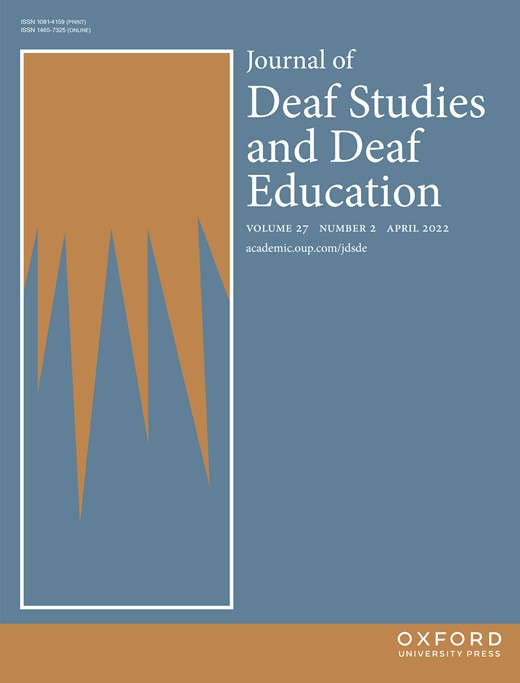-
PDF
- Split View
-
Views
-
Cite
Cite
Stacey Jenkinson, Discussing Bilingualism in Deaf Children: Essays in Honor of Robert Hoffmeister, The Journal of Deaf Studies and Deaf Education, Volume 27, Issue 2, April 2022, Page 202, https://doi.org/10.1093/deafed/enab041
Close - Share Icon Share
Discussing Bilingualism in Deaf Children: Essays in Honor of Robert Hoffmeister, edited by Charlotte Enns, Jonathon Henner, and Lynn McQuarrie, is a collection of essays on critical topics in bilingual deaf education with a focus on current best practices. Each essay draws on the work of Dr. Robert Hoffmeister, a pioneer and leader in the field of deaf education. Early on, Hoffmeister recognized the merit of deaf children having access to American sign language (ASL) for establishing a language foundation needed for higher-level thinking and development. As researcher and professor, Hoffmeister promoted deaf scholarship by creating spaces for deaf views in the field. This book is evidence of his commitment to deaf education through the many contributing authors who studied under his tutelage and are helping to change the face and direction of deaf education today.
For educators of the deaf or practitioners interested in learning more about bilingual deaf education, this book is a valuable resource. The reader is presented with cultural and linguistic practices integrated into teaching strategies, curricula, and assessment. Practitioners will value the breadth and depth of the information covered.
This book examines the history of and best practices in deaf education. The organization of this book will appeal to educators of the deaf. The collection is organized into three sections:
Part I: Seaworthy Construction: Theoretical Underpinnings of Bilingual Deaf Education, begins with a historical walk through two centuries of deaf education in America. It opens to show the shift from a history of hearing paternalism and oppression toward deaf leadership and innovation exploring deaf agency. Other essays investigate the need for early sign language acquisition among deaf children, features of ASL and its use in the classroom, and acquiring English via print.
Part II: Launching the Voyage: Bilingual Teaching Strategies for Deaf Students, focuses on bilingual teaching strategies in the classroom. Essays in this section explore the use of ASL and bilingual practices to facilitate literacy and mathematics instruction. This includes an exploration of recently developed bilingual writing and reading curricula designed specifically for bilingual deaf students.
Part III: Sailing Through the Wind: Challenges of Signed Language Assessment, looks at ASL assessments and their usefulness in guiding instruction with bilingual deaf learners. The ASLAI is one such assessment, developed by Dr. Hoffmeister and his mostly deaf team of researchers, educators, and linguists. It provides a tool to assess ASL development and remediation among deaf children, giving teachers a means to help elevate the status of ASL in the classroom.
Most of the essays focus on sign language acquisition and assessment and literacy acquisition, with one chapter devoted to mathematics. As a result, the text lacks bilingual instructional practices for other core subjects. Additionally, the basis for the book is Hoffmeister’s contribution to and influence in the field of deaf education. As a result, other bilingual teaching strategies and practices developed by researchers and practitioners outside of the sphere of Hoffmeister’s influence are not included.
In conclusion, Discussing Bilingualism in Deaf Children, Essays in Honor of Robert Hoffmeister, affords readers an array of best practices in deaf bilingual education and its continued development and evolution. Hoffmeister’s contribution to the field of deaf education cannot be overlooked. Hoffmeister recognized that to change the field of deaf education meant including and promoting deaf views. Thus, his impact in the field of bilingual deaf education will be lasting.


